May 30, 2025 | 00:20 GMT +7
May 30, 2025 | 00:20 GMT +7
Hotline: 0913.378.918
May 30, 2025 | 00:20 GMT +7
Hotline: 0913.378.918
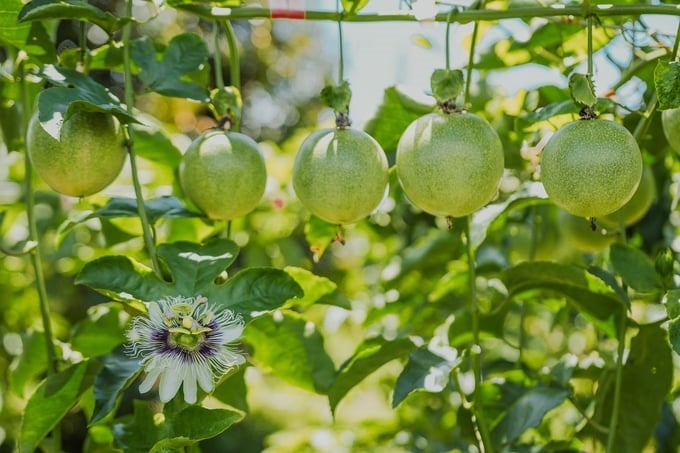
Passion fruit is a fruit tree with high economic value. Photo: Nguyen Van Viet.
Passion fruit (Passiflora edulis) is a new fruit tree with high nutritional and economic value. Passion fruit is grown mainly in the Central Highlands and Northwest, with an area of about 10,500 ha in 2019. In 2023, according to data from seedling supply companies, the growing area increased to about 17,000 ha. Currently, passion fruit ranks 17th among fruit trees with a production area larger than 10,000 ha.
However, passion fruit production in Vietnam also faces many limitations. Passion fruit productivity fluctuates greatly between regions. The whole country's average yield is 20.3 tons/ha; in the Central Highlands, it is 26.1 tons/ha; in Son La, it is 10.1 tons/ha; and in Nghe An, it is 17.3 tons/ha. The highest productivity in the Central Highlands provinces can reach 50–60 tons/ha, while the Northwest provinces can reach 30 tons/ha.
One of the biggest barriers to passion fruit production in Vietnam is its unsustainability and unstable market. These two factors closely influence each other.
The unsustainable production factor is due to the severity of pests and diseases, especially viral diseases, fungal diseases such as Fusarium sp., Rhizoctonia sp., and Phytophthora sp., and diseases caused by bacteria and fungi such as Alternaria sp., Pseudomonas syringae, etc.
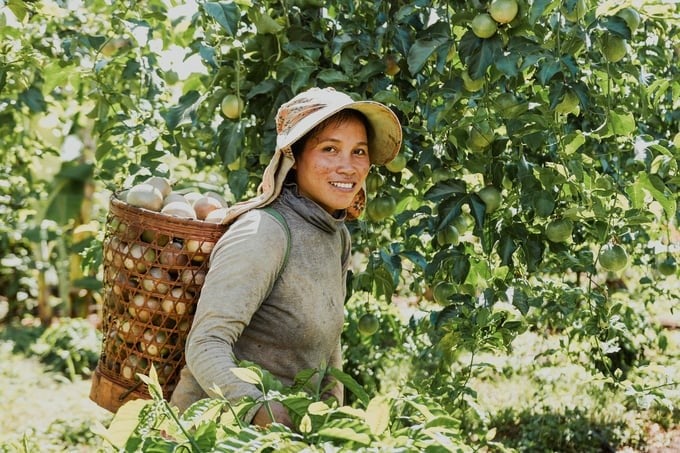
Some garden owners who produce passion fruit of high standards can earn up to USD 20,000/ha. Photo: Nguyen Van Viet.
Currently, we are lacking good disease-resistant passion fruit varieties. Some other limitations include passion fruit farming techniques. Many farmers do not have enough knowledge about soil treatment, crop rotation, growing and care techniques, especially farming techniques in drought and flood conditions, and seasonal yield and quality management to ensure sustainable production and control pests and diseases. Besides, post-harvest, preservation, and processing technology is also limited, leading to uncontrolled production.
Therefore, the economic efficiency of growing passion fruit among farmer households varies greatly. Some garden owners can produce passion fruit of high standards to export fresh fruit to Europe at prices of USD 1.5–2/kg, earning over USD 20,000/ha. However, many garden owners can only sell passion fruit at low prices and earn much less income.
The unsustainable market factor is because the passion fruit market is not stable and depends heavily on exports while not focusing on the domestic market and not diversifying products. When there is good output, the selling price of passion fruit increases (as in 2022–2023), and people massively expand the area, leading to oversupply that causes a surplus and a serious decline in the selling price. When the selling price decreases and investment efficiency drops, growers do not continue to care for passion fruit gardens, resulting in reduced productivity and quality and aggravating the instability of production.
Nafoods Group Joint Stock Company is a leading business in Vietnam in producing disease-free passion fruit seedlings, breeding new passion fruit varieties, and developing the passion fruit value chain.
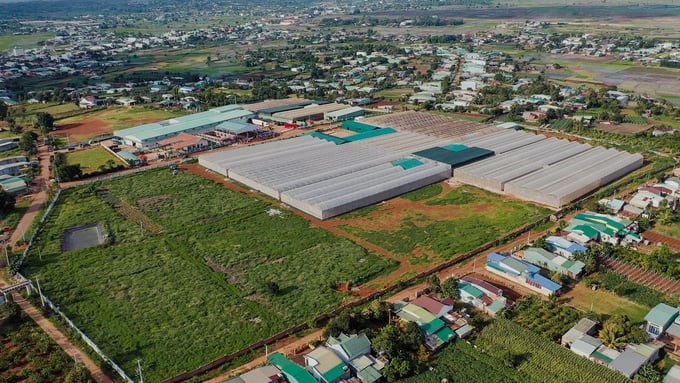
Nafoods' passion fruit value chain is closed from seed – linked growing area – processing – market. Photo: Nguyen Van Viet.
Currently, Nafoods is the top 1 exporter of passion fruit products in Asia and the top 3 exporters of passion fruit juice concentrate in Vietnam. The unit accounts for 60% of the market share of passion fruit seedlings and was awarded the gold prize for high-tech passion fruit seedlings by the General Council of Agriculture and Rural Development Viet Nam in 2022. Every year, Nafoods processes over 25,000 tons of passion fruit and exports it to 70 countries around the world.
Nafoods' passion fruit value chain includes a closed chain from seed - linked growing area - processing - market.
Disease-free plant varieties
Regarding the seed field, Nafoods has now completely mastered the technology of producing disease-free seedlings and breeding new passion fruit varieties. Nafoods has two passion fruit seed production companies in Nghe An and Gia Lai with an isolated net house area of 10 ha and a production capacity of 10 million disease-free seedlings/year, providing over 60% of the market share of disease-free passion fruit seedlings for production.
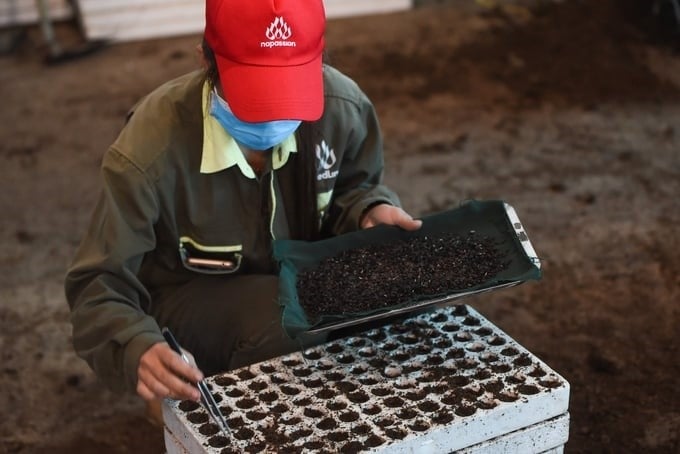
Nafoods has now completely mastered the technology of producing disease-free seedlings. Photo: VAN.
Nafoods' passion fruit seedlings are produced according to high technology and are certified by the Ministry of Agriculture and Rural Development. Nafoods has been a high-tech agricultural business since 2019, with a laboratory for testing viral diseases using molecular biology to ensure 100% of the seedlings supplied to the market are disease-free and traceable to their origin by QR code.
Breeding materials are passion fruit varieties approved for circulation by the Ministry of Agriculture and Rural Development, including the Tai Nong 1 variety originating from Taiwan, Nafoods 1, Que Phong 1, and three other varieties selected by Nafoods that have been granted exclusive protection certificates. Nafoods has diversified its variety set for processing (Tai Nong 1, Que Phong 1, GL.01, GL.02) and for fresh consumption (Nafoods 1, Nafoods 2, Bach Huong 1, and some yellow passion fruit varieties).
In the coming time, Nafoods aims to create disease-resistant passion fruit varieties to adapt to increasingly complicated developments in climate and environment.
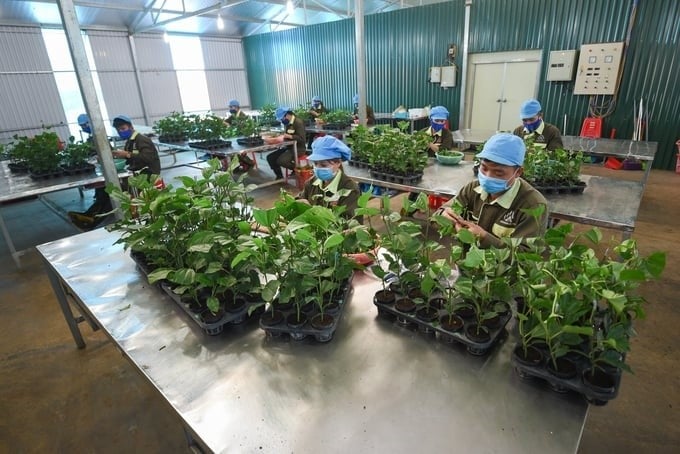
In the coming time, Nafoods will focus on breeding disease-resistant passion fruit varieties. Photo: Tung Dinh.
Organizing raw material areas
This is a complex field that is very difficult to control. Nafoods has organized growing areas linked with cooperatives and farmer households on an area of over 5,000 ha. Farmers in linkage are trained in farming techniques, provided with seedlings from Nafoods, and bought products after harvest by Nafoods according to the quantity and price agreed between the two parties. To control food quality and safety, Nafoods has organized contract models with farmers and cooperatives specializing in growing passion fruit according to VietGAP standards.
Nafoods has organized passion fruit growing areas and has been granted over 12 growing area codes by the General Administration of Customs of China and the Plant Protection Department, qualified to export passion fruit to China. Nafoods has also organized growing areas that meet GlobalGAP standards and are qualified to export fresh fruit to some EU countries.
The farming techniques that Nafoods pays special attention to researching and training for farmers include soil treatment techniques, crop isolation and rotation to cut off sources of pathogen infection, growing and care techniques, fertilizing, pruning, etc., especially farming techniques in the dry and rainy seasons to both produce sustainably and manage pests and diseases.
Nafoods is continuing to research and perfect growing and care techniques, prioritizing farming and biological measures that combine disease-resistant and disease-free varieties for sustainable production, creating safe products, and controlling residues below the allowable level.
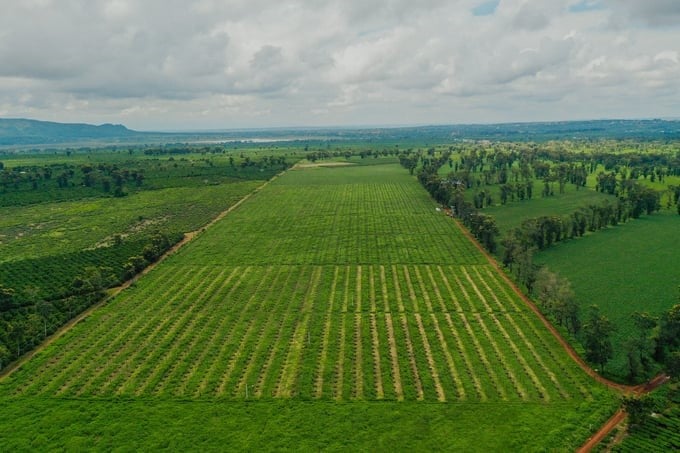
Nafoods has organized passion fruit growing areas and has been granted 12 growing area codes. Photo: Nguyen Van Viet.
Processing and market
In the processing and market fields, Nafoods has an ecosystem of processing factories with modern technology in Long An, Gia Lai, Nghe An, and Son La, creating products that meet international standards. Main products include concentrate, IQF (quick frozen product), juice, dried product, fresh fruit, etc. Factories process over 25,000 tons of raw fruit/year.
The main consumption markets include the EU, the US, some Gulf countries, South Korea, Japan, China, some other Asian countries, and the domestic market. Nafoods is continuing to apply modern technologies in processing and preservation, diversify processed products, and diversify markets.
Passion fruit trees have the potential to develop in Vietnam, creating products with very unique flavors because they are grown in regions with different climates and bring high value. However, passion fruit is very sensitive to pests and diseases and weather and climatic conditions, so it is necessary to organize production and apply farming and pest management techniques methodically along the value chain to achieve high efficiency.
Translated by Thu Huyen
/2025/05/25/4127-3-073637_820.jpg)
(VAN) Thanks to the promotion from an FAO-implemented project, vegetable production in greenhouses in Moc Chau has seen strong development, from 1.5 hectares in 2021 to nearly 50 hectares in 2024.

(VAN) FAO has recently supported USD 140,000 to implement the project 'Risk mitigation human-animal interface risks through disease control initiatives in pig farming.'

(VAN) The People's Committee of Tra Vinh province has approved an adjustment to the investment policy for the Green Hydrogen Plant project, increasing its area to approximately 52.76 hectares.
![Reducing emissions from rice fields: [2] Farmers’ commitment to the soil](https://t.ex-cdn.com/nongnghiepmoitruong.vn/608w/files/news/2025/05/05/dsc08881jpg-nongnghiep-140632.jpg)
(VAN) Clean rice cultivation model in Thuong Tan commune, Bac Tan Uyen district, is assisting local residents in achieving sustainable agriculture by substantially reducing costs, increasing productivity, and protecting the environment.

(VAN) At the conference to disseminate Resolution No. 68, AgriS introduced its digital agricultural ecosystem and reaffirmed its commitment to accompanying the Government in promoting private sector development and sustainable agriculture.

(VAN) 'Blue Ocean - Blue Foods' initiative is designed to restore marine ecosystems and establish sustainable livelihoods for local communities by cultivating a minimum of 1,000 hectares of cottonii seaweed in the first three years.
/2025/05/21/4642-3-112707_603.jpg)
(VAN) The V-SCOPE project has made direct contributions to three out of six pillars of the Comprehensive Strategic Partnership between Vietnam and Australia.